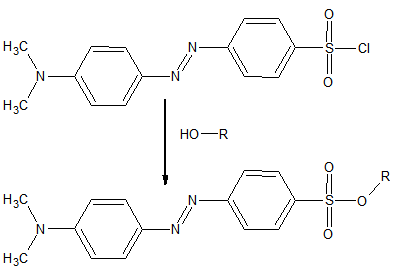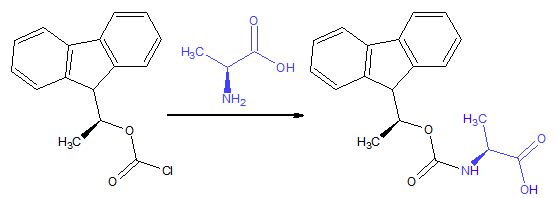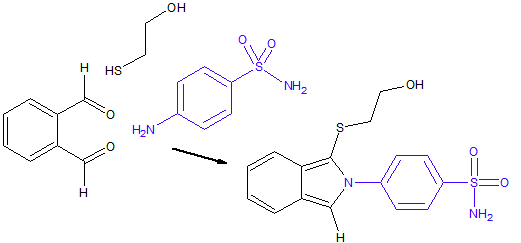Part 2 – Liquid Chromatography
N. Reuter*, ACG Global Technical Support for CSD, Middelburg, The Netherlands
Introduction
Wikipedia defines “derivatization“ as follows:
Derivatization is a technique used in chemistry, which transforms a chemical compound into a product of similar chemical structure, called a derivative.
Generally, a specific functional group of the compound participates in the derivatization reaction and transforms the educt to a derivative of deviating reactivity, solubility, boiling point, melting point, aggregate state, or chemical composition. Resulting new chemical properties can be used for quantification or separation of the educt. Derivatization techniques are frequently employed in chemical analysis of mixtures
That means derivatization is “wet“ chemistry. Though chromatographers may not prefer this type of chemistry, it is quite often used for specific purposes, as mentioned in the first paragraph of the word definition. Something similar, but different.
In HPLC, derivatizations can be more complex than their GC counterparts, because of the condensed state in which everything takes place. Increasing volatility is only a possible issue for LC/MS applications. Where-as all derivatizations in GC are pre-column, in HPLC you also can have post-column processes.
Classic Pre-Column Derivatizations
Pre-column derivatizations are carried out as off-line chemical reactions between reagent and sample prior to the injections on the HPLC column.
Figure 1: Flow path of a standard HPLC analysis with pre-column derivatization.
Chromotags
If volatility is not the issue, then detectability is. The classic detector in HPLC is the UV detector, so com-ponents need to be UV-active to be detected. If the molecule is not, you need to insert so-called chromophores into the molecules. Reagents that do this are called chromotags. This table lists common chromotag reagents:
Reagent Abbreviation
Full Name
Dbs-Cl (Dabsyl chloride)
4-Dimethylamino-azobenzene-4'-sulfonic acid chloride
DNBA
3,5-Dinitrobenzyloxyamine hydrochloride
DNBC
3,5-Dinitrobenzoylchloride
DNBDI
O-(3,5-Dinitrophenylmethyl)-N,N-diisopropylthiourea
DNPBA
3,5-Dinitrophenylmethyl n-propylamine hydrochloride
FDNB
Fluoro-2,4-dinitrobenzene
NIC
1-Naphthylisocyanate
Ninhydrine
4,5-Benzo-2,2-dihydroxy-cyclopentan-1,3-dione
PBPB
p-Bromophenyl bromomethyl keton
PITC
Phenylisothiocyanate
PNBA
O-(p-Nitrophenylmethyl)hydroxylamine hydrochloride
PNBA
O-(p-Nitrophenylmethyl)hydroxylamine hydrochloride
PNBDI
O-(p-Nitrophenylmethyl)-N,N-diisopropylthiourea
PNBPA
p-Nitrophenylmethyl n-propyl amin hydrochloride
SDPNA
N-Succinimidyl-3,5-dinitrophenylacetate
SNPA
N-Succinimidyl-p-nitrophenylacetate
Table 1: Common chromotag reagents.
All of these reagents carry at least one aromatic ring or even larger pi-electron systems, which are responsi-ble for the UV detection. Dabsylchloride can, for example, be used to derivatize amines, thiols, imidazoles, phenols and alcohols.
Figure 2: Dabsylation of alcohols.
A typical procedure is as follows:
General procedure: Derivatives are formed within 30 minutes at room temperature or at 70 °C in 10 minutes in acetone, buffer or acetonitrile.
Example for alcohols: Mix 1 mL of alcohol with 10 mL 100 mM sodium bicarbonate and 20 mL 10 mM dabsyl chloride, reflux for 10 minutes, cool, extract with diethylether, wash with pH 3 citrate buffer, evaporate the organic layer, reconstitute and inject an aliquot.
Fluorotags
Besides the standard UV detection, fluorescence detection is also often used in HPLC. Chemical reagents called fluorotags are used to introduce groups with fluorescent properties into the molecules. Table 2 shows a list of common fluorotag reagents:
Reagent Abbreviation
Full Name
AECF
2-(9-Anthranyl)ethyl chloroformate
BDMQ
3-Bromomethyl-6,7-dimethoxy-1-methyl-2(1H)-quinoxalinone
BMC (BrMmC)
4-Bromomethyl-7-methoxycoumarine
BrMaC
4-Bromomethyl-7-acetoxycoumarine
DANS hydrazide
1-Dimethylaminonaphthalene-5-sulfonic acid hydrazide, Dansyl hydrazide
Dithiobis(amino-dimethoxybenzene
2,2'-Dithiobis(1-amino-4,5-dimethoxybenzene)
Dns-Cl (DANS-Cl)
1-Dimethylaminonaphthalene-5-sulfonic acid chloride, Dansyl chloride
EDTN
1-Ethoxy-4-(dichloro-s-triazinyl) naphthalene
Fluorescamine (FLURAM)
4-Phenylspiro(furan-2(3H),1'-phthalan)-3,3'-dione
FMOC
(9-fluorenyl)methyl chloroformate
HCPI
2-(4-Hydrazinocarbonylphenyl)-4,5-diphenylimidazole
NBD-Cl
7-chloro-4-nitrobenzyl-2-oxa-1,3-diazole
NBD-F
7-Fluoro-4-nitrobenzyl-2-oxa-1,3-diazole
NDA
Naphthalene dicarboxaldehyde
OPA
o-Phthaldialdehyde
Table 2: List of common fluorotag reagents.
(9-Fluorenyl)alkyl chloroformates, like the methyl derivative, FMOC, or the ethyl derivative, FLEC, are often used for amines and amino acids. The ethyl derivative carries an asymmetrically substituted/chiral carbon atom and is also available enantiomerically pure in both enantiomers, so that it is possible to check for both enantiomers of, for example, an amino acid due to the formation of diastereomeric derivates on an HPLC column with an achiral phase:
Figure 3: Derivatization of (S)-alanine with (S)-1-(9-fluorenyl)ethyl chloroformate (FLEC).
A typical procedure for chloroformate reagents is as follows:
In the absence of water: Add 5 µL of the chloroformate to 2-10 µL of the sample in acetone in a mix-ture of acetonitrile/pyridine/alcohol (22:2:1, alcohol: methanol, ethanol or chloroethanol) and shake for some seconds. Inject.
In the presence of water: To 50 µL of a pyridine-water solution (5:1), 50 µL acetonitrile/ethanol (2:3) and 5 µL chloroformate are added. Extraction is performed by 100 µL hexane and 200 µL water. In-ject an aliquot of the hexane layer.
Fluorotags are often also chromotags due to extended aromatic systems in the reagent’s structure, but chromotags typically are not also fluorotags.
Volatility Reagents for LC/MS
This is about acylation reactions with perfluorinated organic acid anhydrides, like trifluoroacetic acid anhy-dride or the homologous pentafluoropropanoic and heptafluorobutanoic acid anhydrides. Acylation reactions are described in part one of this document, which was about gas chromatography.
Post-Column Derivatizations/Online Derivatizations
Post-column derivatizations are online chemical reactions, carried out after the separation has taken place and before the component enters the detector:
Figure 4: Flow path of a standard HPLC analysis with post-column derivatization.
An example for the method used in Figure 4 is the post-column fluorotag derivatization of sulfonamides [1]:
Figure 5: Post-column derivatization of Sulfanilamide (blue) with benzene-1,2-dicarbaldehyde (OPA) and 2-sulfanylethanol. The exitation can be measured at 302 nm and the emission at 412 nm wavelengths.
Another possibility for post-column reactions are immobilized enzyme reactors (IMERs), where an enzyme is used to catalyze certain reactions before the component goes to the detector. An example is the reaction of acetylcholine to choline and the oxidation from choline to carboxy-N,N,N-trimethylmethanaminium, an acid and hydrogen peroxide, that can be easily detected by an electrochemical detector down to low picomole/femtomole levels [2]. The first reaction (1) is catalyzed by acetylcholine esterase and the second (2) by choline oxidase, two enzymes immobilized in the IMER reactor.
Figure 6: enzyme-catalzed derivatization from acetylcholine to choline and the corresponding acid.
Drawbacks
If you inject a sample together with an unreacted derivatization reagent or their reaction products, it can happen that the baseline noise increases, but normally the detection is so specific that the sensitivity still increases.
For post-column systems you will need another pump for the reagent and the mixing/reaction chamber.
Compared to the amount of standard reagents in gas chromatography, the amount for HPLC reagent is enormously higher and you have lots of specific reactions for specific components. In fact, every reaction in organic chemistry may be a derivatization reaction for HPLC components.
Conclusions
Derivatizations in liquid chromatography are used to:
- Insert UV active groups
- Insert fluorescent groups
- Insert or generate electro-chemically measurable groups
- Enhance volatility for LC/MS applications
References
- P. Viñas, C. L. Erroz, N. Campillo, M. Hernández-Córdoba; ”Determination of sulfonamides in foods by liquid chromatography with post-column fluorescence derivatization”, J. Chromatogr. A, 726, 1996, 125-131.
- G. Damsma, D. Lammerts van Bueren, B. H. C. Westerink, A. S. Horn; “Determination of acetylcholine and choline in the femtomole range by means of HPLC, a post-column enzyme reactor, and electrochemical detection“, Chromatographia, 24(1), 1987, 827-831.
Recommended Literature
- G. Lunn, L. C. Hellwig; “Handbook of Derivatization Reactions for HPLC”, Wiley-Intersciece, New York 1998. ISBN 978-0471164585.
- D. R. Knapp; “Handbook of Analytical Derivatization Reactions”, Wiley-Intersciece, New York 1979. ISBN 978-0471034698.
- K. Blau, J. M. Halket; “Handbook of Derivatives for Chromatography”, Wiley-Interscience, New York 1993. ISBN 978-0471926993.
- T. Toyo'oka; “Modern Derivatization Methods for Separation Science”, Wiley-Interscience, New York 1999. ISBN 978-0471983644.
- S. C. Moldoveanu, V. David; “Sample Preparation in Chromatography” (J. Chromatogr. Library Vol. 65), Elsevier Scientific, Amsterdam 2002. ISBN 978-0444503947.







